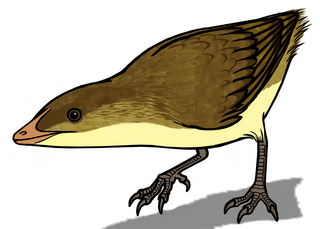
The Enantiornithes, also known as enantiornithines or enantiornitheans in literature, are a group of extinct avialans, the most abundant and diverse group known from the Mesozoic era. Almost all retained teeth and clawed fingers on each wing, but otherwise looked much like modern birds externally. Over eighty species of Enantiornithes have been named, but some names represent only single bones, so it is likely that not all are valid. The Enantiornithes became extinct at the Cretaceous–Paleogene boundary, along with Hesperornithes and all other non-avian dinosaurs.

Yanornis is an extinct genus of fish-eating Early Cretaceous birds. Two species have been described, both from Liaoning province, China: Yanornis martini, based on several fossils found in the 120-million-year-old Jiufotang Formation at Chaoyang, and Yanornis guozhangi, from the 124-million-year-old Yixian Formation.

Jeholornis is a genus of avialans that lived between approximately 122 and 120 million years ago during the early Cretaceous Period in China. Fossil Jeholornis were first discovered in the Jiufotang Formation in Hebei Province, China and additional specimens have been found in the older Yixian Formation.
Omnivoropteryx is a genus of primitive flying avialan from the early Cretaceous Upper Jiufotang Formation of China. The authors who described Omnivoropteryx, Stephen Czerkas and Qiang Ji, stated that their specimen closely resembles Sapeornis, but the pubis was longer and, since no skull was known for Sapeornis, they did not consider the two names synonyms. The later discovery of Sapeornis skulls shows that they were indeed similar to Omnivoropteryx. This may make Omnivoropteryx a junior synonym of Sapeornis, and the name may be abandoned.

Sapeornis is a monotypic genus of avialan which lived during the early Cretaceous period. Sapeornis contains only one species, Sapeornis chaoyangensis.

Eoalulavis is a monotypic genus of enantiornithean bird that lived during the Barremian, in the Lower Cretaceous around 125 million years ago. The only known species is Eoalulavis hoyasi.

Cathayornis is a genus of enantiornithean birds from the Jiufotang Formation of Liaoning, People's Republic of China. It is known definitively from only one species, Cathayornis yandica, one of the first Enantiornithes found in China. Several additional species were once incorrectly classified as Cathayornis, and have since been reclassified or regarded as nomina dubia.

Sinornis is a genus of enantiornithean birds from the Lower Cretaceous Jiufotang Formation of the People's Republic of China.

Cuspirostrisornis is a genus of enantiornithean bird. Only one species is known, Cuspirostrisornis houi, though some researchers believe this to be a synonym of the similar species Cathayornis yandica. It is known from one fossil found in the Jiufotang Formation in Liaoning province, People's Republic of China. The Jiufotang Formation is dated to the Early Cretaceous period, Aptian age, 120.3 +/-0.7 million years ago.
Largirostrornis is a genus of enantiornithean bird. One species has been named, Largirostornis sexdentoris. It lived during the Early Cretaceous and is known from fossils found in the Jiufotang Formation in Liaoning province, People's Republic of China. Some researchers believe this species to be a junior synonym of the similar Cathayornis yandica.

Liaoxiornis is a dubious genus of enantiornithine bird. The only named species is Liaoxiornis delicatus, described by Hou and Chen in 1999. Because the species was named for a hatchling specimen, it cannot be matched with adult specimens, and so it is impossible to determine which, if any, birds from the same rocks represent adults of this species. Luis Chiappe and colleagues therefore regarded it as a nomen vanum or at least a nomen dubium, and recommended that use of the name be abandoned.

Yixianornis is a bird genus from the early Cretaceous period. Its remains have been found in the Jiufotang Formation at Chaoyang dated to the early Aptian age, around 120 million years ago. Only one species, Yixianornis grabaui, is known at present. The specific name, grabaui, is named after American paleontologist Amadeus William Grabau, who surveyed China in the early 20th century.
Paleontology or palaeontology is the study of prehistoric life forms on Earth through the examination of plant and animal fossils. This includes the study of body fossils, tracks (ichnites), burrows, cast-off parts, fossilised feces (coprolites), palynomorphs and chemical residues. Because humans have encountered fossils for millennia, paleontology has a long history both before and after becoming formalized as a science. This article records significant discoveries and events related to paleontology that occurred or were published in the year 2002.

Pygostylia is a group of avialans which includes the Confuciusornithidae and all of the more advanced species, the Ornithothoraces.

Protopteryx is an extinct bird and the most basal enantiornithean, from the Cretaceous period. The type species is P. fengningensis. It was first discovered in the Sichakou Member of the Yixian Formation or Huajiying Formation of Hebei Province, northern China, dating from 131 Ma ago. Protopteryx has been found in the Daibeigou formation, as well. The name Protopteryx means "primitive feather": "proto-" meaning "the first of" and "-pteryx" meaning "feather" or "wing." The name comes from the fact that Protopteryx feathers are more primitive than those of modern birds, such as the two elongated tail feathers that lack barbs and rami.
Zhongjianornis is a genus of beaked, pigeon-sized birds from the early Cretaceous period of China. It is known from one fossil found at Jianchang, Liaoning Province, in rocks of the Jiufotang Formation, representing the type species Zhongjianornis yangi.

Euornithes is a natural group which includes the most recent common ancestor of all avialans closer to modern birds than to Sinornis.
Houornis is a genus of enantiornithean birds from the Jiufotang Formation of Liaoning, People's Republic of China. It is known from a single species, Houornis caudatus, which had been once been classified as a species of Cathayornis, and has also been regarded as a nomen dubium.

Cratoavis is a genus of enantiornithines. The type and only currently described species is C. cearensis, from the Early Cretaceous of Araripe Basin, Ceará, Brazil. The fossil, an articulated skeleton with feathers attached to the wings and surrounding the body, extends considerably the temporal record of the group at South America.















